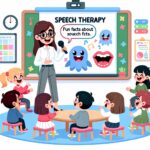Are you ready to take your speech therapy sessions to a whole new level? Get ready to transform your approach with our latest article on mastering engaging speech therapy. In this captivating piece, we will explore the secrets to creating effective sessions that empower both therapists and clients alike. Whether you’re a seasoned speech therapist looking to add some new strategies to your toolkit or an individual seeking to enhance your communication skills, this article will provide you with valuable insights and techniques that will undoubtedly elevate your therapy experience. So, buckle up and get ready for an immersive journey into the world of engaging speech therapy!

Engaging Speech Therapy Sessions
When it comes to speech therapy, engagement is key. By creating sessions that are interesting, interactive, and tailored to the individual’s needs, we can maximize their progress and empower them on their communication journey. In this article, we’ll explore practical strategies and techniques for mastering engaging speech therapy sessions, ensuring that both therapists and clients find them effective and enjoyable.
Offer Choices to Increase Engagement
One effective way to boost engagement in speech therapy sessions is by offering choices. By providing options, we give clients a sense of control and autonomy, which can increase their motivation and investment in the process. For example, when working on vocabulary development, we can present different activities or games and let the client choose which one they would like to use. By providing choices, we encourage active participation and make the therapy session a collaborative experience.
Incorporate Movement to Keep Clients Engaged
Sitting still for an extended period can be challenging for many clients, particularly children. Incorporating movement into speech therapy sessions can help alleviate this issue and keep clients engaged. For instance, we can introduce activities that involve gestures, actions, or physical games to embed speech and language practice within movement. By integrating movement, we make sessions more dynamic and interactive, ensuring that clients remain focused and motivated.
Ensure High Rates of Success
Engagement often stems from a sense of achievement. To foster this, it’s crucial to provide activities and tasks that are achievable for clients. By setting realistic goals and breaking down complex tasks into smaller, manageable steps, we can ensure a high rate of success and boost engagement. When clients experience regular success, they are more likely to stay motivated and actively participate in their speech therapy sessions.
Cater to Sensory Needs with Sensory Activities
Every client is unique and may have different sensory preferences and needs. Integrating sensory activities into speech therapy sessions can be highly effective in engaging clients and catering to their sensory requirements. For example, using tactile materials, such as sand, clay, or textured objects, can enhance engagement and facilitate language learning. By incorporating sensory activities, we create a stimulating and inclusive therapy environment that motivates clients to participate and learn.
Provide Timely Breaks to Maintain Engagement
Sustaining focus and attention for an entire speech therapy session can be challenging, especially for clients with attention difficulties or fatigue. To prevent burnout and maintain engagement, it’s important to include regular breaks during the session. These breaks allow clients to recharge, process information, and refocus their attention. By offering timely breaks, we ensure that clients remain energized and attentive throughout the session, optimizing their progress.
Empowering Language Development Through Activities
Language intervention activities play a significant role in speech therapy sessions. To improve language development, speech-language therapists can utilize various resources like pictures, books, objects, and technology-based tools. These materials facilitate vocabulary expansion, grammar practice, storytelling, and conversational skills. By incorporating engaging activities that target specific language goals, therapists can create a dynamic and interactive learning environment for their clients.
Early Intervention: From Singing to Goals
Early intervention speech therapy sessions are crucial for children with speech and language delays. These sessions often involve a combination of singing, playing with toys, and working towards established goals. Through a structured yet playful approach, speech therapists can engage young clients, stimulate their language development, and support their overall communication progress. By making the sessions fun and tailored to the child’s interests, therapists set a strong foundation for future engagement and growth.
Boosting Engagement in Virtual Speech Therapy
In today’s digital age, virtual speech therapy sessions have become increasingly prevalent. Ensuring engagement during these sessions requires additional considerations. Therapists can chat with the child at the beginning of the session to establish a connection, offer a sense of control by involving the child in decision-making, actively engage caregivers as partners in the learning process, and leverage competition and engaging materials to maintain interest and participation. By adapting strategies for the virtual environment, therapists can create engaging virtual sessions that support the client’s progress.
Engaging speech therapy sessions are essential for empowering clients and maximizing their communication potential. By incorporating choices, movement, achievable tasks, sensory activities, and breaks, therapists can create an environment that fosters motivation, focus, and success. Through tailored language intervention activities and early intervention approaches, clients can actively participate and enjoy their therapy sessions. Whether in-person or virtual, speech therapy sessions can be engaging platforms for growth and development.
Speech Pathologists play a vital role in improving communication skills and enhancing the lives of individuals with speech and language disorders. If you or a loved one is struggling with speech impediments or language difficulties, seeking the help of a qualified Speech Pathologist can make a world of difference. Our dedicated team of experts at Speech Pathologist is committed to providing personalized therapy and comprehensive evaluations to address a wide range of speech and language challenges. Whether it’s articulation difficulties, stuttering, or cognitive-communication disorders, our skilled professionals are here to guide you towards effective communication strategies and help you express yourself with confidence and clarity. Don’t let speech obstacles hold you back; click here to learn more about our services and embark on a journey towards improved communication skills.
FAQ
Question 1: How can offering choices to students increase engagement in speech-language therapy sessions?
Answer 1: Offering choices to students in speech-language therapy sessions can increase engagement by giving them a sense of control and autonomy. When students have the opportunity to make decisions about activities or tasks, they are more likely to feel motivated and invested in the session. It allows them to have a sense of ownership in their therapy process and encourages active participation.
Question 2: How can movement be incorporated into therapy sessions to keep students engaged?
Answer 2: Incorporating movement into therapy sessions can help keep students engaged by adding a dynamic element to the activities. Movement can be introduced through gestures, actions, or physical games that require students to use their bodies while practicing speech and language skills. This not only makes the sessions more interactive and fun but also helps facilitate kinesthetic learning and increases overall engagement.
Question 3: How can speech therapists ensure high rates of success during therapy sessions?
Answer 3: Speech therapists can ensure high rates of success during therapy sessions by providing activities and tasks that are achievable for students. It is important to set realistic goals and to adapt the difficulty level based on the individual’s abilities. By breaking down complex skills into smaller, manageable steps, therapists can build a sense of accomplishment and help students experience success, which in turn boosts engagement and motivation.
Question 4: Why is it important to include sensory activities in speech-language therapy sessions?
Answer 4: Including sensory activities in speech-language therapy sessions is important because it caters to the sensory needs of students and helps engage multiple senses. Sensory activities can involve using tactile materials, manipulating objects, or incorporating elements of music and sound. By stimulating different sensory modalities, therapists can enhance the learning experience, increase attention and focus, and create a more enjoyable and interactive therapy environment.
Question 5: Why is it necessary to provide breaks during therapy sessions?
Answer 5: Providing breaks during therapy sessions is necessary to prevent fatigue and maintain student engagement. Speech therapy sessions can be mentally demanding, and students may experience cognitive overload or exhaustion over time. By allowing short breaks, students can recharge, process information, and refocus their attention. Breaks also provide opportunities for movement and sensory exploration, which can further enhance engagement and overall session effectiveness.
- Unlocking Francis Alexander Shields’ Finance Empire: A Comprehensive Biography - July 12, 2025
- Unveiling Francis Alexander Shields: A Business Legacy - July 12, 2025
- Francis Alexander Shields’ Business Career: A Comprehensive Overview - July 12, 2025















